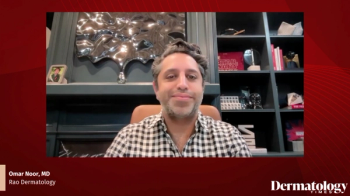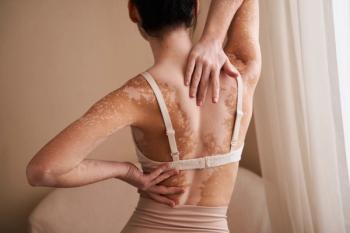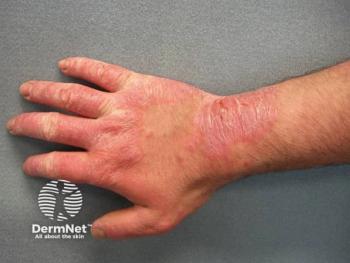
Low BSA Psoriasis Can Carry High Disease Burden

Key Takeaways
- Traditional BSA thresholds for psoriasis severity may not accurately reflect disease burden, affecting access to systemic therapies.
- Patients with low BSA can have a comparable disease burden to those with higher BSA, challenging current treatment eligibility criteria.
New insights reveal that those with low BSA involvement often face significant disease burdens, challenging traditional treatment criteria.
For decades, psoriasis severity has often been classified using body surface area (BSA) thresholds—less than 3% for mild disease, 3–10% for moderate, and more than 10% for severe. This framework influences access to systemic therapies, particularly biologics, with many payers requiring BSA > 10% to justify coverage.1 However, new data from the CorEvitas Psoriasis Registry challenge the assumption that patients with low BSA have a lower disease burden.2
The analysis, published earlier this year in Dermatology and Therapy, evaluated patient-reported outcomes (PROs) across BSA categories in systemic therapy–naïve patients initiating biologic treatment between April 2015 and September 2023. Participants were grouped as low (< 3% BSA), medium (3–10%), or high (> 10%). Researchers examined quality of life, itch, skin pain, fatigue, psoriatic arthritis (PsA) screening, and disease history at treatment initiation.
Study Methods and Materials
Of 1,640 eligible patients, 7.0% had low BSA, 46.9% medium, and 46.2% high. Mean age was 45.8 years, and about half were men. The most frequently prescribed biologics were IL-23 inhibitors (41%), followed by IL-17 inhibitors (34%), TNF inhibitors (16%), and IL-12/23 inhibitors (8%).
Patients with higher BSA tended to be older, male, and have more comorbidities such as obesity and depression. Interestingly, the low-BSA group had a higher prevalence of PsA based on dermatologist diagnosis or a PEST score ≥ 3 (43.0% vs. ~29% in medium and high BSA groups).
Commonality of High-Impact Sites
Nearly half of patients in the low-BSA group (46.5%) had psoriasis in high-impact areas, such as the scalp, nails, palms/soles, or intertriginous zones. These locations are often more symptomatic, harder to treat, and more disruptive to daily life.
Quality-of-life scores told a similar story. While mean Dermatology Life Quality Index (DLQI) scores rose with BSA (6.6 in low, 7.8 in medium, 9.6 in high), researchers found there was substantial overlap. Itch, skin pain, and fatigue scores followed the same pattern—higher averages with more BSA but large distributional overlap across groups.
Analysis
To quantify this, investigators used an overlap statistic based on the Mann–Whitney method. A value of 0.50 indicates complete similarity between groups.
- For high vs. medium BSA, PRO overlaps ranged from 0.52 to 0.59.
- For high vs. low BSA, overlaps ranged from 0.60 to 0.70.
For disease characteristics and medical history, overlaps between groups were even closer, with most falling between 0.44 and 0.58.
In practical terms, this means a randomly selected patient with low BSA could have an equal or greater symptom burden than a patient with high BSA in a substantial proportion of comparisons.
Implications
These findings align with current guidelines from the American Academy of Dermatology, the National Psoriasis Foundation, and the International Psoriasis Council, which recommend assessing disease burden beyond BSA alone. Factors such as high-impact site involvement, PsA presence, failure of topical therapies, and quality-of-life impairment should guide systemic treatment decisions.
However, insurance requirements in many regions still rely heavily on BSA cutoffs, potentially delaying effective treatment for patients with low BSA but significant disease impact. The authors note that the low proportion of low-BSA patients in the registry may reflect selective prescribing—dermatologists reserving biologics for those with more severe symptoms or comorbidities despite limited skin involvement.
Strengths and Limitations
Strengths of the study include its large, real-world dataset and standardized PRO collection from more than 20,000 patients across the CorEvitas Registry. The cross-sectional design at biologic initiation provides insights into real-life prescribing decisions.
Limitations include potential changes in BSA and symptom scores prior to registry enrollment (patients could have started biologics up to 12 months earlier) and the smaller size of the low-BSA group, which may limit statistical precision. Additionally, higher PsA prevalence in the low-BSA group may have influenced fatigue and other PRO results.
Conclusion
At the time of biologic initiation, patients with low BSA psoriasis often experience a disease burden comparable to those with extensive skin involvement. This supports a more individualized approach to treatment eligibility—one that weighs quality-of-life impact, symptom severity, and special-site disease alongside BSA percentage.
As the authors conclude, these results “support the appropriateness of considering biologic therapies for patients with psoriasis with low BSA involvement and indicators of high disease burden,” reinforcing the need for nuanced assessment in clinical decision-making and payer policy.
References
- Krueger GG, Feldman SR, Camisa C, et al. Two considerations for patients with psoriasis and their clinicians: what defines mild, moderate, and severe psoriasis? What constitutes a clinically significant improvement when treating psoriasis?.J Am Acad Dermatol. 2000;43(2 Pt 1):281-285. doi:10.1067/mjd.2000.106374
- Armstrong AW, Feldman SR, Fitzgerald T, et al. Patient-reported outcomes by baseline body surface area involvement among individuals initiating biologic therapy: Results from the CorEvitas psoriasis registry. Dermatol Ther (Heidelb). 2025;15(8):2117-2130. doi:10.1007/s13555-025-01456-5
Newsletter
Like what you’re reading? Subscribe to Dermatology Times for weekly updates on therapies, innovations, and real-world practice tips.



















